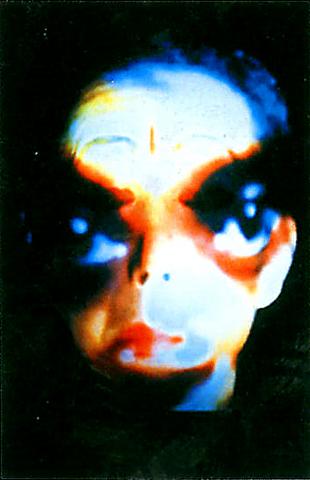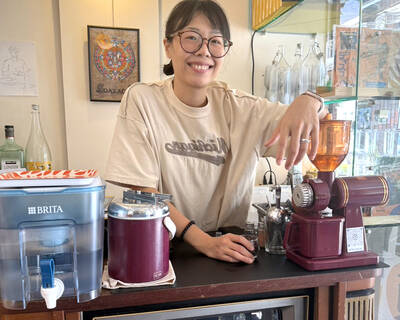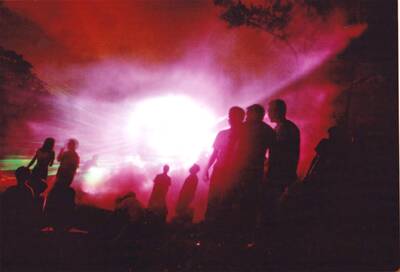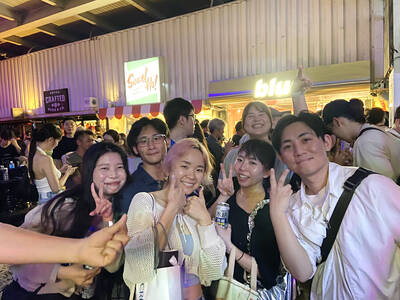In 1993, Singaporean artist Binghui Huangfu was at the opening of the Mao Goes Pop -- Chinese Contemporary Art after 1989 exhibition in Beijing when she heard a question posed.
"Why is it that among the nearly 200 artists in the show, is there only one female artist?"

PHOTO COURTESY OF TFAM
The curator replied: "The work of female artists is too sentimental. Their work lacks philosophical meaning and are not mature enough to be included."
At these words, Huangfu questioned whether female artists in China, or anywhere else, might really be the unthinking amateurs so described. In the following years, Huangfu traveled around Asia to get to know female artists in this part of the world where female artists are often viewed as no more than dabblers.
Her findings ran contrary to that description. Text and Subtext -- Contemporary Asian Women Artists, currently on show at the Taipei Fine Arts Museum, showcases Huangfu's research. The exhibition, featuring the work of 22 female artists from nine Asian countries, has been touring Australia, Sweden and Norway over the past two years.
"It's a manifesto stating that there are plenty of sophisticated works by female Asian artists and that their concerns are universal," said Huangfu, who is curatoring the exhibition.
Singaporean Suzann Victor's installation Dusted by Rich Manouevre looks back over Singapore's colonial past. South Korean artist ium's video, Highway, reflects on the consequences of ever-faster urban development. Varsha Nair's installation Point 33 -- Ether explores human reaction to separate spaces. Berlin-based Chinese artist Qin Yufen's Silent Wind explores the effects of different contexts on consumer products.
Huangfu broadened her selection of artists to include not just artists working in Asia but also artists of Asian ancestry. Comparing the works of Chinese American Hung Liu and Chinese Zhang Xin or Vietnamese Australian My Le Thi and Vietnamese Nguyer Thi Chau Giang, viewers can speculate about the effects of a Western environment on Asian women artists.
"In South Korea, 83 percent of college art majors are girls. Only 10 percent of them continued to pursue a career in art. Art institutes are viewed as finishing schools through which girls become better wives," said Huangfu, giving an example of the oppressive environments Asian women live in.
During her research, Huangfu discovered some touching stories.
In the early 1980s, Indonesian Arahmaiani wrapped blood-smeared bandages around electricity poles to highlight frequently occurring street accidents. The act quickly landed her in a mental hospital. Although she achieved worldwide renown, Arahmaiani was not recognized at home until 1999.
Vietnamese oil painter Hguyer Thi Chau Giang shows much innovation in her works. However, in Vietnamese art circles, she is treated in the traditional way. Huangfu once asked her why male artists like her to hang out with them. "So that I can cook for them," Huangfu quoted her as saying.
Viewers will not find loud feminist statements in this cross-section of work. However, they are decidedly feminist in the way they try to express their cultures and surroundings, and are as creative as their male counterparts.
WHAT: Text and Subtext -- Contemporary Asian WomenArtists
WHERE: Taipei Fine Arts Museum, 181, Chungshan N. Rd., Sec. 3, Taipei
WHEN: until Feb. 16

Cheng Ching-hsiang (鄭青祥) turned a small triangle of concrete jammed between two old shops into a cool little bar called 9dimension. In front of the shop, a steampunk-like structure was welded by himself to serve as a booth where he prepares cocktails. “Yancheng used to be just old people,” he says, “but now young people are coming and creating the New Yancheng.” Around the corner, Yu Hsiu-jao (饒毓琇), opened Tiny Cafe. True to its name, it is the size of a cupboard and serves cold-brewed coffee. “Small shops are so special and have personality,” she says, “people come to Yancheng to find such treasures.” She

In July of 1995, a group of local DJs began posting an event flyer around Taipei. It was cheaply photocopied and nearly all in English, with a hand-drawn map on the back and, on the front, a big red hand print alongside one prominent line of text, “Finally… THE PARTY.” The map led to a remote floodplain in Taipei County (now New Taipei City) just across the Tamsui River from Taipei. The organizers got permission from no one. They just drove up in a blue Taiwanese pickup truck, set up a generator, two speakers, two turntables and a mixer. They

Former Chinese Nationalist Party (KMT) chairwoman Hung Hsiu-chu’s (洪秀柱) attendance at the Chinese Communist Party’s (CPP) “Chinese People’s War of Resistance Against Japanese Aggression and the World Anti-Fascist War” parade in Beijing is infuriating, embarrassing and insulting to nearly everyone in Taiwan, and Taiwan’s friends and allies. She is also ripping off bandages and pouring salt into old wounds. In the process she managed to tie both the KMT and the Democratic Progressive Party (DPP) into uncomfortable knots. The KMT continues to honor their heroic fighters, who defended China against the invading Japanese Empire, which inflicted unimaginable horrors on the

Hannah Liao (廖宸萱) recalls the harassment she experienced on dating apps, an experience that left her frightened and disgusted. “I’ve tried some voice-based dating apps,” the 30-year-old says. “Right away, some guys would say things like, ‘Wanna talk dirty?’ or ‘Wanna suck my d**k?’” she says. Liao’s story is not unique. Ministry of Health and Welfare statistics show a more than 50 percent rise in sexual assault cases related to online encounters over the past five years. In 2023 alone, women comprised 7,698 of the 9,413 reported victims. Faced with a dating landscape that can feel more predatory than promising, many in